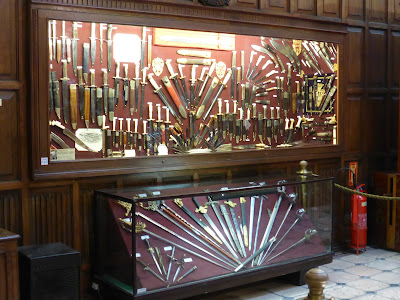 |
| Marco Zero |
The hostel was definitely a highlight of the trip. It was very colourful and crazy and had a lot of common space were every night some of the guests started to play some music with the instruments on the walls. We used the chance to improve our Brazilian cooking skills and learned how to make Tapioca! Tapioca is a kind of pancake or wrap out of manioc that can be filled with whatever you want. The funny thing about it is, that you put the tapioca flour directly in the pan without any water and it somehow melts together.
One day we dedicated the Brennand family. First we went to the Oficina Cerâmica Francisco Brennand - a huge gallery with all the ceramic art works of him.
Afterwards we went to the Instituto Ricardo Brennand. He was the cousin of Francisco Brennand and an excessive collector of medieval artifacts. Also he owns a library about history and arts. He build an actual castle to present his collection to the world!
 |
| Statue of Gutenberg |
Another day we went to the beaches of Boa Viajem (translated good journey) near our hostel.
Inside an old prison we visited an arts and crafts fair. In every cell was another little souvenir store.
We also visited the Cais do Sertão. It's a really beautiful and interactive museum about the Sertão region in the north-east of Brazil a bit inland, where the landscape is more like a desert.
The little things on the next photo that look like little bones are in reality tasty snacks out of manioc starch. It's a type of fluffy chips.
Two hours from Recife is Porto de Galinhas (translated Chicken Port). The name comes from the time when slave trade was already forbidden but slavery not yet. It was still common to have slaves, but it was illegal to buy or sell slaves. In Porto de Galinhas the forbidden shiploads arrived declared as chickens. Today Porto de Galinhas is a very known and popular holiday spot with nice reefs for snorkeling and diving.
Just half an hour north of Recife is the colonial town Olinda. It's a great example of Portuguese architecture.
Olinda is also famous for the hugh dolls for carnival. They are carried through the streets on the shoulders and represent known Brazilian personalities.
We also tried some new exotic fruits! On the next photo you see the fruit of cashew nuts. The reddish-yellow part can be eaten raw. The part that looks like a stem contains the cashew nut. It has to be roasted in a complicated process before it can be eaten because the shell contains corrosive oils.
 |
| Caju |
 |
| Pinha |



















































No comments:
Post a Comment